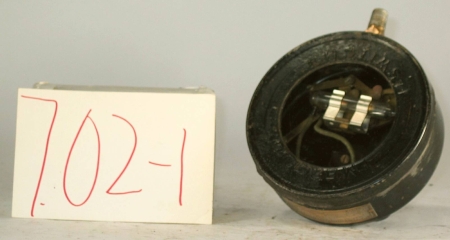Refrigerating and Air Conditioning Pressure and Temperature Controls – Commercial
An early, commercial application, hydraulic bellows actuated, dual function, automatic pressure and temperature control, for refrigeration systems requiring extended capillary tube temperature sensing; similar to ID # 152, except with tilting mercury tube not included, Mercoid, 1930.
One of a matched set of similar Mercoid, early refrigeration system controllers. The set profiles a range of temperature/pressure control applications met by this pioneering manufacture, employing various design modifications made to the same basic configuration [See items ID # 153- 155].
Features:
Note large electrical junction box with 4 electrical connector knock-outs, representative of the wiring practice approved for commercial equipment of the period, which required heavy steel shielded twin conductor cable referred to as BX.
Technical Significance:
An exemplar of what is likely the first generation of wide spread, commercially manufactured and marketed pressure and temperature refrigeration controllers, popularly found in Canada.
Connected by a small copper tube to the refrigeration compressor, this dual bellows controller provided high pressure cut-out protection. As well, it provided low side, refrigerator temperature control by means of a thermal bulb on the end of long coiled capillary tube attached to a second hydraulic bellows. The bulb would likely have been attached to the refrigeration-cooling unit [evaporator]. A simple ingenious mechanical mechanism allowed the mercury switch to be operated by either bellows, turning the refrigeration on or off in response to both high pressure and refrigerator temperature
The electrical switching properties of mercury had been discovered and the tilting mercury bulb would become the switching method of choice for much of the early 20th century for fractional HP applications. It was a period in which little empirical design data was available on alternating current switching. With an induction motor rating of up to 1 HP, and a split-phase rating of 1/4 HP this controller and most like it of the period was limited to fractional HP applications.
One of a matched set of similar Mercoid, early refrigeration system controllers, profiling a range of temperature/pressure control applications met by this pioneering manufacture, employing design modifications made to this basic configuration. This economic, robust configuration provided a platform readily adaptable to a wide range of commercial refrigeration field requirements [See items ID # 153- 155].
Industrial Significance:
A range of corporate names appear on the controls in the series, suggesting a range of corporate partnerships between Mercoid and other early players in the refrigeration control field: American Radiator Company; The Federal Gauge Company; Detroit Lubricator Company. The genre would give way within the decade to smaller, more sophisticated engineering approaches, yielding increasingly more precise refrigeration system control [See ID # 163 to 165].


